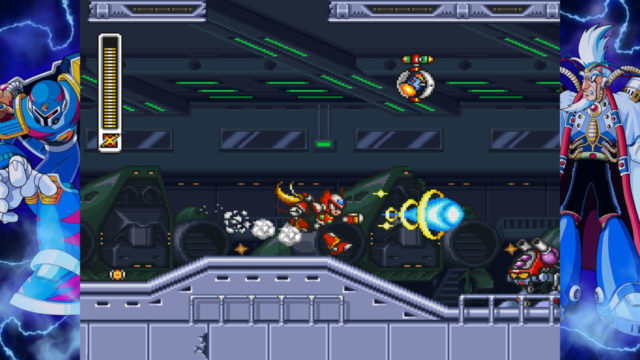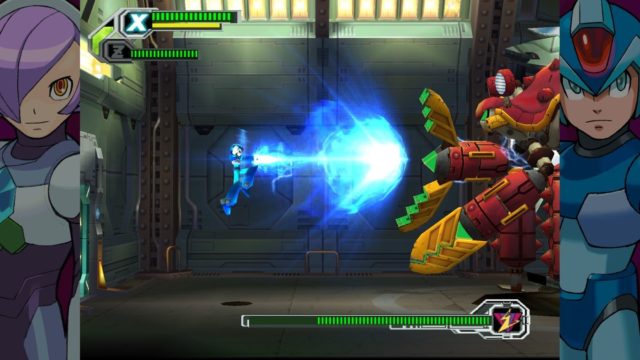An astounding compilation of some of the best run and gun platformers ever made; delightful presentation allows fans new and old to customize how they want to see these classics on their TV screens; Museum mode is deep and full of info; some incredible soundtracks here; beautiful visuals across all three platforms that these games originally debuted on, now in HD!
The SNES X trilogy has visual stuttering that's inexcusable; X7 and X8 are the weakest entries in the series and comprise half of the second X Legacy Collection, making it the weaker of the two
As with Mega Man Legacy Collection 1+2, we will be delivering two separate grades for each compilation here, as they can be purchased individually. There is also one, cumulative grade for both collections combined.
The 1990s was a decade that saw numerous technological advancements and innovations, including the proliferation of wireless communications, the evolution of the Internet, and, perhaps more pertinent to our interests, the dawn of powerhouse video game consoles like SNES and Sega Genesis. Nintendo’s SNES represented the zeitgeist of the era; where the ’80s is often portrayed as a time of excess, the ’90s is typically conveyed as the embodiment of extremes. Super Nintendo was NES to, well, the extreme, with bigger and better graphics, higher concept games, and edgier content overall. Many of the familiar franchises born on NES made their way to SNES, but some underwent major facelifts in the transition, including Mega Man.
One of the masterminds behind the Blue Bomber was Keiji Inafune. He’d helped bring six Mega Man titles to NES, with the final installment dropping during the second year of SNES being on the market. It was clear that Mega Man would be making the move to Nintendo’s new home console, but for Inafune it wouldn’t be as simple as giving the series a visual overhaul. Inafune was adamant that in order to survive, Mega Man would need to evolve to keep up with the changing tastes of gamers. RPGs, in particular, had caught Inafune’s eye, as the genre was dominating in Japan. Japanese gamers were enamored with those games’ more intricate storylines, darker characters, and complicated mechanics.
Mega Man X represented the leap into the future that Inafune believed was necessary for Rock and friends to survive the shifting video game landscape. While eventually it became clear that Mega Man as a franchise can handle multiple interpretations at once, this first departure was a major undertaking for Capcom that was meant to be the new face for the character and his world. By all accounts (including this writer’s), Mega Man X is one of the greatest run and gun platformers ever created. It took the non-linear exploration of Mega Man (along with the ability to harvest new weaponry from defeated foes) and merged it with more intense action and combat, a rocking soundtrack, and cutting-edge visuals.
It was, you know, Mega Man to the extreme! I promise I won’t type that word again.
All kidding aside, Inafune’s instincts were proven correct. This new version of Mega Man (now dubbed X) was accompanied by an ally named Zero (himself essentially an upgraded take on Proto Man— although if Inafune could have had his way, he would have actually been Mega Man’s new design!), and the duo would go on to appear in five more games together. The six Mega Man X games were split across SNES, PlayStation/Sega Saturn, and PlayStation 2, with the final game releasing in 2004. With Mega Man X Legacy Collection 1+2, fans are finally able to experience the entirety of the series on a Nintendo platform.

Mega Man X through X6 had previously been collected in Mega Man X Collection on GameCube back in 2006. That anthology in many ways represented the best that the series had to offer. There’s really no getting around the fact that Mega Man X7 and X8 are the weakest entries the X-line has to offer, and sadly they comprise an entire half of Legacy Collection 2, rendering it the weaker of these two “volumes” on offer, here. That’s being generous, as there are some people who aren’t all that fond of X5 and X6, either (I call them loonies). Let’s break the two collections down and really hammer out what to make of them.
Mega Man X Legacy Collection 1 is home to Mega Man X through X4. The first X remains, hands-down, one of the finest games ever made. Its gameplay is tight, its soundtrack iconic (none of the other seven games come within sniffing distance of it), and it remains the purest of the X games in terms of concept and execution. Later entries arguably became a bit bloated with extraneous storytelling and gameplay mechanics that, while fun, didn’t necessarily add enough to the experience to warrant their inclusion. Regardless, X2 and X3, the follow-ups that hit SNES, were very fun titles in their own ways, especially for bringing Zero into the fold as a playable character. The play controls, presentation, and soundtracks for these three SNES entries are still a delight to this day, putting numerous other contemporary titles to shame. There is some screen stuttering that seems tied to the emulator used by Capcom which is frustrating and unfortunate, but ultimately doesn’t mar the experience or gameplay.

Mega Man X4, meanwhile, represents the series’ first installment on PlayStation. The leap from X3 to X4, from a graphical standpoint, is like the difference between night and day. It’s not that the visuals in X4 are better, so to speak, but they’re drastically different. Gone are the pixel graphics of SNES, replaced instead with PlayStation’s more detailed and intricate sprites. Everything on-screen is buttery smooth, colorful, and bright, looking like it all came from an anime or manga. Throw in some fun (albeit cheesy) animated cinematics, and X4 really pushed the presentation envelope in a way that the series never had before. In regards to gameplay, X4 is much the same as its predecessors, but is undeniably even faster paced and intense with more and larger enemies filling the screen than previously seen.
All four of these X titles represent the best entries in the series. Here, the gameplay is the most refined and straightforward, with less of the superfluous extras that came to be tacked on with X5 forward. As was the case with Mega Man Legacy Collection 1 + 2, there are countless extra goodies in tow to entice fans new and old to give these classic games a shot. Screen filters allow for a customized viewing experience that can skew as modern or retro as the player desires. There’s also the comprehensive Museum mode which offers a litany of facts, art, and history all relating to the series.

Rookie Hunter mode, meanwhile, ensures that newbie X players can dip their toes into a slightly less piranha-infested pool. The difficulty level of the X series is very high, which can be a turn-off to many gamers these days. Rookie Hunter bumps up X and Zero’s defenses and damage output, making it easier to take on the challenge of the different Mavericks and baddies littered throughout the games. On the opposite end of the spectrum is the X Challenge mode, which pits players against two random boss characters simultaneously. It’s murderously tough, and should give even the most grizzled of Mega Man X veterans a run for their money.
So that’s all well and good, but what about Mega Man X Legacy Collection 2? It has all of the features and modes that I described above, but there are four different games to play: Mega Man X5 through X8. Of the four titles represented here, X5 is easily the best. It was the last X title that Inafune had a direct hand in creating and skews closest to the quality of the original quartet of X games. It plays differently than those titles, however, in that there’s a “time” system where every Maverick encounter takes an hour off of a ticking clock. This results in multiple endings that can only be seen by playing the game more than once. It’s an interesting hook, but debatable in terms of how much fun it actually adds. Nevertheless, it does help to break the formula up a bit.
After Inafune’s departure, Capcom still managed to churn out three more X sequels. X6 is the last entry on PlayStation and plays much like X4 and X5. It’s very fun, albeit not quite as innovative as what came before. X7 and X8, meanwhile, arrived on PlayStation 2 and suffered from many of the pitfalls of the era that other, longtime series succumbed to. There’s nonsensical 3D shoved in where it doesn’t belong and overall the action just doesn’t feel as smooth or immersive as its predecessor. The PS2 X titles definitely aren’t awful, but they’re the weakest two offerings in the entire series. X Legacy Collection 1 is clearly the superior compilation, but X Legacy Collection 2 is still a quality time to be had. Just don’t expect the same level of thrills.
Mega Man X Legacy Collection 1+2 is a stunning achievement by Capcom that should be a compulsory buy for platformer and retro gaming enthusiasts alike. Its presentation is as good as it gets, with its bevy of extras and historical content acting as icing on an already succulent cake. There are some blemishes in the emulation of the SNES X games, and the second half of the series doesn’t live up to the quality of the first, but as a whole these compilations represent some of the greatest run and gun shooters to ever grace a gaming console— which seems to be par for the course for the Blue Bomber!
Mega Man X Legacy Collection 1
Rating: A-
 1up Mushroom for…
1up Mushroom for…
Delightful presentation and extras; play control is tight and exhilarating; the evolution of the original Mega Man series represented here pushed the franchise forward and is still engaging to this day
 Poison Mushroom for…
Poison Mushroom for…
Screen shaking is present in the first three X games from the SNES era— inexcusable for games that played with no hiccups on hardware that’s nearly thirty years old.
Mega Man X Legacy Collection 2
Rating: B
 1up Mushroom for…
1up Mushroom for…
The same caring polish in the first collection is present here, alongside all the extras; tight controls and fun gameplay
 Poison Mushroom for…
Poison Mushroom for…
The level of quality really dips with X7 and X8— they’re enjoyable but simply not in the same league as X5 and X6




 ShareThis
ShareThis





